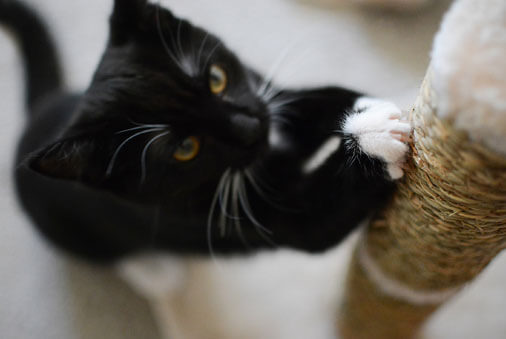So to help keep your kitten from becoming a scaredy cat, you need to socialize her when she’s young. Adopting a kitten gives you the chance to start early and create a strong bond that ensures you and your cat get on well for years.
Mother knows best
Just like all mothers, adult cats need time alone with their babies but you can gently handle her kittens not long after they’re born, as long as you keep Mama cat calm. If she seems stressed by your presence, wait until she leaves the room before mingling with her babies.
A kitten’s best teacher will always be her mom; she’ll learn all her feline behaviors and skills by watching how the mother cat behaves, so it’s better for your kitten to stick with her siblings and mom until she’s about 10 weeks old.
If you know that the litter hasn’t had much human contact, it’s best to bring them home sooner. Your veterinarian can tell you the optimal time to separate kittens from their feline family based on their home-life after they’re born.
Let the socialization begin
Human interaction helps socialize kittens and is vital for their development, but start slowly.
Set up a small safe space
When kittens are anxious or scared, they’ll find hiding places, which is less than ideal for bonding. Create a temporary safe space, such as in your bathroom, where your kitten can't hide but will still feel comfortable. Include her food, water and litter box.
Avoid startling her
Kittens are easily startled, so use a calm voice and approach them from their sides. Try not to put your hand directly in your kitten's face or swoop down to pet her. Move to her level by sitting or lying beside her before petting.
Food = trust
Food can be love and that’s certainly true for our furry family members. Bond with your kitten during her mealtime so she draws a positive association with human interaction. You can also reward her with a tasty treat after petting her to develop trust. In time your kitten will come close to you for affection whether food is present or not.
One meet & greet at a time
When introducing your kitten to new people, whether they’re friends or family, allow only one new person to interact with her at a time. You can monitor the play date to make your kitten more comfortable. Too many new people at once can overwhelm and stress your kitten, which can reverse her socialization progress.
- Let your kitten meet new people so she learns to trust different personalities. Never force interactions. Your kitten needs to feel completely comfortable. Patience is essential because kittens need to learn they can trust humans.
- Introduce your kitten to safe interactive toys and allow her to explore different surfaces from carpet and concrete, to grass, gravel, linoleum, and wood.
- Expose your kitten to the great outdoors slowly (read: a fenced-in yard or play area) so she gets some fresh air while you’re with her.
- Spend at least 15 minutes every day socializing and playing with your kitten, especially when you first bring her home. Naturally, the more time you can spend, the better.
Play’s the thing
Kittens are far from catatonic. Playful exercise is extremely important for socializing felines. Teaching your kitten how to play nice by interacting with her every day gives her the appropriate outlet for all her youthful energy.
Feathers rock — not fingers
To keep your kitten from confusing human limbs with toys, don’t use your hands and feet when you play with her. Kittens don’t know the difference between a playful nip or a painful one so you need to train them that humans aren’t chew toys.
If your rambunctious kitten treats humans as pounce toys, redirect her play. Make your hands or feet go limp in front of her, say “no” firmly, then distract her with a feathered wand or other toy.
She’ll soon learn hands aren’t a stimulating challenge but interactive toys are. Playing with your kitten regularly with toys will sidetrack her to fun, not flesh.
Been there, played with that
Kitten play isn’t always child’s play. Cats need physical activity but they become easily jaded. Here are a few tips to hurdle any boredom:
- Buy several toys to find out which ones she likes best
- Engage your kitten by showing her how the toy works. Simply placing
something in front of her is not playing with her - Stimulate her with new toys when she’s tired of an old one.
- Hide her toys then bring them out later so they feel “new”
- Rotate where you store her toys so she’ll discover them in new places
- Play with toys that engage all her senses: sight, sound, smell and touch
- Paper bags and cardboard boxes may interest your kitten more than cat toys so
keep some handy
Always give your kitten plenty of time to adjust to new toys, people, pets and situations. A little interaction can go a long way, but watch out for overstimulation because down time is important too.





